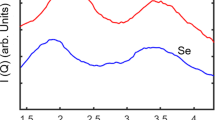Abstract
The kinetics of structural relaxation in vitreous boron oxide and sodium borate glass containing 5.5 mol % Na2O during isothermal treatment at a number of temperatures after cooling from high temperatures and a sharp increase in the temperature of samples stabilized at T < T g for different times is studied by the small-angle X-ray scattering (SAXS) technique. It is shown that, as the fictive temperature of samples approaches the temperature at which the supercooled liquid transforms into a noncrystalline solid state, the times of development of a structural inhomogeneity that arises in the samples after a drastic increase in the temperature increase considerably in a narrow temperature range (1–2 K). The intensity of small-angle X-ray scattering by a micro-inhomogeneous structure formed in the course of relaxation processes in chemically inhomogeneous glasses substantially exceeds the SAXS intensity observed during structural relaxation of vitreous boron oxide. This is associated with the increase in the sizes of structural inhomogeneity regions in the matrix in heterogeneous samples as compared to the sizes of similar regions in homogeneous glasses. Stresses arising in heterogeneous samples during structural relaxation are responsible for the interference effects that substantially affect both the SAXS intensity at angles close to zero and, correspondingly, the light scattering intensity.
Similar content being viewed by others
References
Golubkov, V.V., A Problem of Inhomogeneous Glass Structure, Fiz. Khim. Stekla, 1998, vol. 24, no. 3, pp. 289–304 [Glass Phys. Chem. (Engl. transl.), 1998, vol. 24, no. 3, pp. 196–207].
Golubkov, V.V., Structural Relaxation in B2O3 in the Glass Transition Range, Fiz. Khim. Stekla, 1989, vol. 15, no. 3, pp. 467–479.
Bokov, N.A. and Andreev, N.S., Light Scattering by Sodium Germanate Glass after Temperature Jumps in the Glass Transition Range, Fiz. Khim. Stekla, 1999, vol. 25, no. 2, pp. 40–46 [Glass Phys. Chem. (Engl. transl.), 1999, vol. 25, no. 2, pp. 125–129].
Bokov, N.A. and Andreev, N.S., Specific Features of Light Scattering in Oxide Glasses in the Glass Transition Range, Fiz. Khim. Stekla, 2004, vol. 30, no. 1, pp. 9–19 [Glass Phys. Chem. (Engl. transl.), 2004, vol. 30, no. 1, pp. 6–13].
Golubkov, V.V. and Shakhmatkin, B.A., Specific Features of Temperature Dependences of the Intensity of Small-Angle X-ray Scattering in Oxide Systems at Liquidus Temperatures, Fiz. Khim. Stekla, 1999, vol. 25, no. 4, pp. 444–453 [Glass Phys. Chem. (Engl. transl.), 1999, vol. 25, no. 4, pp. 335–341].
Golubkov, V.V. and Shakhmatkin, B.A., Investigation of the Phase Diagram of the Na2O-B2O3-SiO2 System by the Small-Angle X-ray Scattering Technique, Fiz. Khim. Stekla, 2004, vol. 30, no. 3, pp. 281–289 [Glass Phys. Chem. (Engl. transl.), 2004, vol. 30, no. 3, pp. 209–214].
Golubkov, V.V., The Structure of B2O3 and Alkali Borate Glasses and Melts, Fiz. Khim. Stekla, 1992, vol. 18, no. 2, pp. 14–33 [Sov. J. Glass Phys. Chem. (Engl. transl.), 1992, vol. 18, no. 2, pp. 105–114].
Golubkov, V.V., Titov, A.P., and Porai-Koshits, E.A., On the Structure of Lithium Borate Glasses According to Small Angle X-ray Scattering Data, Fiz. Khim. Stekla, 1992, vol. 18, no. 2, pp. 46–62 [Sov. J. Glass Phys. Chem. (Engl. transl.), 1992, vol. 18, no. 2, pp. 122–129].
Mazurin, O.V., Roskova, G.P., Aver’yanov, V.I., and Antropova, T.V., Dvukhfaznye stekla: struktura, svoistva, primenenie (Two-Phase Glasses: Structure, Properties, and Applications), Varshal, B.G., Ed., Leningrad: Nauka, 1991.
Myuller, R.L., Electrical Conductivity of Ionic—Atomic Solids: VIII. Concentration Dependence of the Electrical Conductivity for Borate and Silicate Glasses, Zh. Tekh. Fiz., 1956, vol. 26, no. 12, pp. 2614–2627.
Golubkov, V.V. and Porai-Koshits, E.A., Thermal Expansion and Glass Transition of Borate Melts, Fiz. Khim. Stekla, 1991, vol. 17, no. 5, pp. 796–809.
Andreev, N.S., Mazurin, O.V., Porai-Koshits, E.A., Roskova, G.P., and Filipovich, V.N., Yavleniya likvatsii v steklakh (Phase Separation in Glasses), Shultz, M.M., Ed., Leningrad: Nauka, 1974.
Golubkov, V.V., Features of Structure and Its Relaxation in Alkali Borate Glasses, Fiz. Khim. Stekla, 1996, vol. 22, no. 3, pp. 248–260 [Glass Phys. Chem. (Engl. transl.), 1996, vol. 22, no. 3, pp. 186–195].
Author information
Authors and Affiliations
Additional information
Original Russian Text © I.Zh. Bus’ko, O.Yu. Golubeva, V.V. Golubkov, 2006, published in Fizika i Khimiya Stekla.
Rights and permissions
About this article
Cite this article
Bus’ko, I.Z., Golubeva, O.Y. & Golubkov, V.V. Specific features of the kinetics of structural relaxation in microinhomogeneous glasses. Glass Phys Chem 32, 123–135 (2006). https://doi.org/10.1134/S1087659606020015
Received:
Issue Date:
DOI: https://doi.org/10.1134/S1087659606020015



